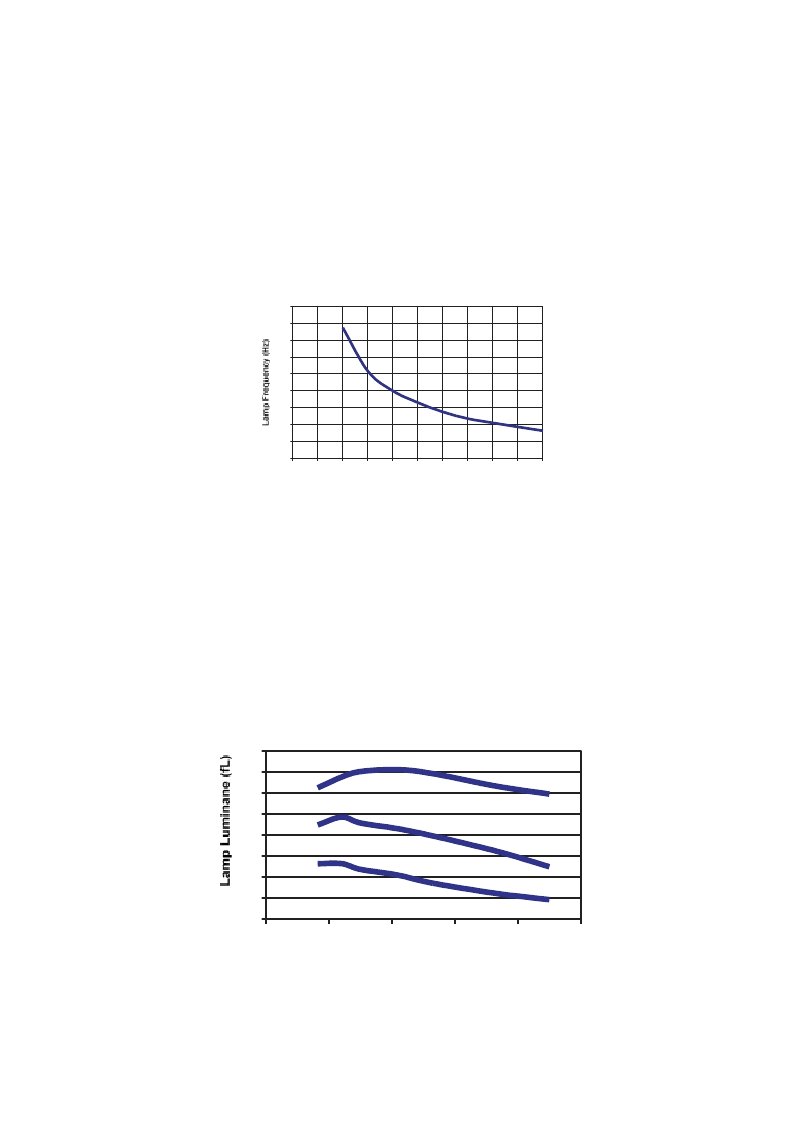- 您現(xiàn)在的位置:買賣IC網(wǎng) > PDF目錄376528 > D355B (Electronic Theatre Controls, Inc.) Electroluminescent Lamp Driver IC PDF資料下載
參數(shù)資料
| 型號(hào): | D355B |
| 廠商: | Electronic Theatre Controls, Inc. |
| 英文描述: | Electroluminescent Lamp Driver IC |
| 中文描述: | 電致發(fā)光燈驅(qū)動(dòng)IC |
| 文件頁(yè)數(shù): | 6/14頁(yè) |
| 文件大小: | 534K |
| 代理商: | D355B |
第1頁(yè)第2頁(yè)第3頁(yè)第4頁(yè)第5頁(yè)當(dāng)前第6頁(yè)第7頁(yè)第8頁(yè)第9頁(yè)第10頁(yè)第11頁(yè)第12頁(yè)第13頁(yè)第14頁(yè)

6
0
1
2
3
4
5
6
7
8
0
200
400
600
800
1000
Lamp Frequency (Hz)
Designing With D355B
I. Lamp Frequency Capacitor (CLF) Selection
Selecting the appropriate value of capacitor for the low frequency oscillator (CLF) will set the output frequency
of the D355 inverter. Figure 1 graphically represents the inversely proportional relationship between the
CLF capacitor value and the oscillator frequency. In this example at V+=3.0V, LF = 1600 nF-Hz/CLF.
Alternatively, the lamp frequency may also be controlled with an external clock signal with a 50% duty
cycle. The output lamp frequency will be the same frequency as the input clock signal. For example, if a
250Hz input clock signal is used, the resulting lamp frequency will be 250Hz. The clock signal input voltage
should not exceed V+.
The selection of the CLF value can also affect the brightness of the EL lamp because of its control of the
lamp frequency (LF). Although input voltage and lamp size can change EL lamp frequency as well, LF
mainly depends on the CLF value selected or the frequency of the input clock signal to CLF. The luminance
of various sizes of
Durel 3 Blue-green EL lamp driven by a D355B at V+ = 3.0V using the same inductor
value is shown in Figure 2 with respect to lamp frequency.
Figure 1: Typical Lamp Frequency vs. CLF Capacitor
4in
2
EL Lamp
2in
2
EL Lamp
6in
2
EL Lamp
Figure 2: Typical Lamp Luminance vs. Lamp Frequency
0
100
200
300
400
500
600
700
800
900
0
1
2
3
4
6
7
8
9
10
CLF5
相關(guān)PDF資料 |
PDF描述 |
|---|---|
| D356A | EL Drivers(EL驅(qū)動(dòng)器) |
| D356A | Electroluminescent Lamp Driver IC |
| D356B | Electroluminescent Lamp Driver IC |
| D360SC4M | Schottky Rectifiers (SBD) (40V 360A) |
| D360SC6M | Schottky Rectifiers (SBD) (60V 360A) |
相關(guān)代理商/技術(shù)參數(shù) |
參數(shù)描述 |
|---|---|
| D355B1 | 制造商:未知廠家 制造商全稱:未知廠家 功能描述:Interface IC |
| D355B2 | 制造商:未知廠家 制造商全稱:未知廠家 功能描述:Interface IC |
| D-355F | 制造商:Triad Magnetics 功能描述: |
| D-356 | 制造商:Triad Magnetics 功能描述: |
| D-356-06 | 制造商:MOLEX 制造商全稱:Molex Electronics Ltd. 功能描述:VersaKrimp? Ring Tongue Terminal for 8 AWG Wire |
發(fā)布緊急采購(gòu),3分鐘左右您將得到回復(fù)。